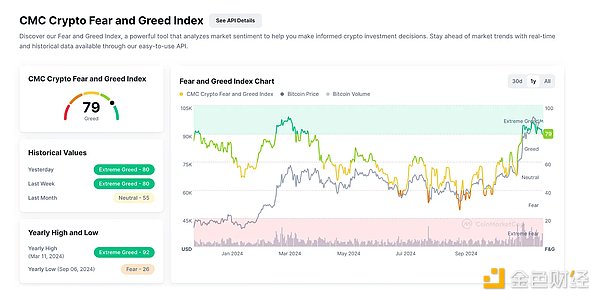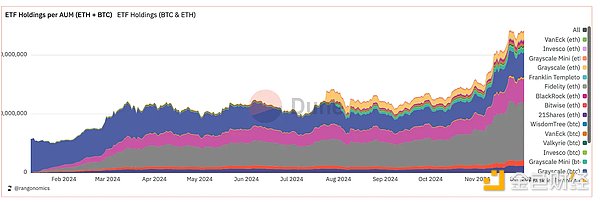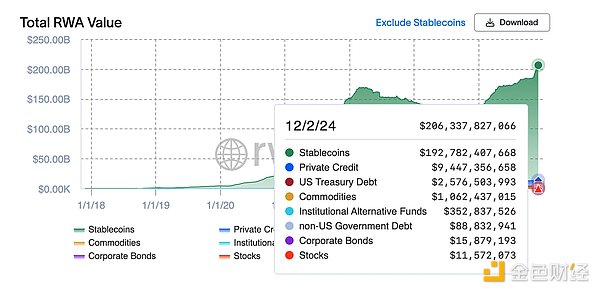Pantera Partners: 2024 Crypto Market Review and 2025 Trend Forecasts

Reprinted from jinse
01/13/2025·29days agoAuthor: Paul Veradittakit, Managing Partner of Pantera Capital Source: veradiverdict Translation: Shan Ouba, Golden Finance
Last week, Coindesk released 8 of my predictions for 2025, and I wanted to publish the full version here, including an overview of the year, a review of my predictions for 2024, and predictions for 2025.
Every year, bulls and bears alike use short-term case studies to predict cryptocurrency destruction or exponential growth. But every year, neither group gets it quite right.
Some of the biggest events this year : Ethereum Dencun upgrade, US election, crypto ETFs, Wyoming DUNA bill, wBTC controversy, Robinhood receives Wells notice, Hyperliquid nearly $2 billion airdrop, Bitcoin breaks $100,000, and SEC Chairman Gary Gensler announced that he would resign in January.
There are no major market shocks in 2024 . While it didn’t bring in a ton of new capital, it proved that more and more cryptocurrency companies are sustainable. Bitcoin has a market capitalization of $1.9 trillion , and all other cryptocurrencies combined are worth $1.6 trillion . The total cryptocurrency market capitalization has doubled since the beginning of 2024.
The diversification of the crypto market increases its ability to respond to shocks. Fields such as payments, DeFi, games, ZK, infrastructure, and consumer applications are all growing, and each subfield has its own funding ecosystem, market, incentive mechanism, and bottlenecks.
This year at Pantera, we 're investing in companies that address these ecosystem-specific problems .
• Crypto gaming companies face difficulties in adopting Web3 data analysis tools, so we invested in Helika , a gaming analytics platform.
• Web3 AI products often face promotion challenges due to the fragmentation of AI technology stacks, so Sahara AI aims to create an all- in-one platform that enables permissionless contributions while maintaining a seamless user experience similar to Web2.
• Intent infrastructure is cluttered and order flow is fragmented, so Everclear standardizes processes by connecting all stakeholders.
• zkVM is complex to integrate , so Nexus takes a modular approach to meet the needs of customers who only need part of the hyperscale layer.
• Consumer applications face the problem of attracting users, so we made our largest ever investment in TON , a blockchain that directly connects to Telegram’s 950 million monthly active users .
In 2025 , we will enter the new year driven by possible regulatory clarity, continued mainstream interest, and rising cryptocurrency prices. Even though markets have been slightly subdued this summer, crypto users are heading into the New Year with a strong sense of optimism (or “greed”).

CoinMarketCap’s Fear & Greed Index
2024 Forecast Review
Last year, I made predictions for this year. Here I rate myself with 1 being the least accurate and 5 being the most accurate .
1. Bitcoin’s resurgence and “DeFi Summer 2.0”
Accuracy: 4/5
• In 2023, Bitcoin price rose from $16,000 in January to a high of $40,000 in December.
• The current price of Bitcoin has exceeded US$90,000 , and Bitcoin dominance rate has exceeded 60% this year .
• There is indeed a Bitcoin DeFi summer , but defining success depends on specific metrics.
• Less than 1% of Bitcoin is wrapped and used in DeFi, with weak growth compared to last year. Bitcoin ecosystems such as Mezo, Stacks, and Merlin have built communities but have struggled with sustained user growth.
• I predicted that Ordinals, inscriptions, and staking might prompt 1% of Bitcoin users to try DeFi , but this prediction did not fully materialize.
However, Babylon , launched this year, which allows users to lock Bitcoin directly without packaging, has attracted about $2 billion in Bitcoin. The price increase also helped TVL reach $3.549 billion , which is 10 times higher than last year (TVL was about $300 million last year), but still far from my prediction of 1% or about 200,000 Bitcoins (currently worth $19 billion ).
2. Tokenized social experience for new consumption scenarios
Accuracy: 2/5
• If meme coins , prediction markets or gambling applications are not included, then this prediction is basically unsuccessful.
• The definition of tokenized social experiences has evolved this year, with the rise and success of on-chain gaming taking center stage.
• Games based on platforms such as TON (Telegram) and Arbitrum have performed well and have successfully integrated tokenization mechanisms into the games.
• Farcaster 's growth (and frames) has leveled off. DePin projects such as Helium, Grass and Blackbird are still in their early stages.
But in terms of new consumption scenarios, there have been few results. We invested in Morph, a global consumer layer, hoping it would become a leader in this area.
3. The growth of “bridges” between traditional finance and DeFi, such as stablecoins and mirror assets
Accuracy: 5/5
• ETF buying continues to grow, with total Ethereum and Bitcoin ETFs reaching a record $119 billion .

ETH and Bitcoin ETF Liquidity
Since the beginning of this year, the number of RWAs has grown by more than 60% to more than $13 billion, and the number of stablecoins has reached an all-time high of $192 billion.

RWA data
Mirrored Assets have become a hot topic, with Ethena, Ondo and M^0 leading the trend of mirrored assets. Assets like sUSDe have annualized yields (APY) of nearly 30% .
Protocols such as Morpho and Pendle allow leverage, yield farming, revolving lending, etc. on these assets.
Protocols such as Superstate further strengthen the direct connection between traditional finance (TradFi) and decentralized finance (DeFi).
4. Cross-integration of modular blockchain and zero-knowledge proof (ZK)
Accuracy: 4/5
Zero-knowledge proof (ZK Proof) is an efficient method of verification or proof that has been successfully integrated into multiple blockchains and protocols as an infrastructure component.
• Polygon, Conduit and OP Stack now integrate SP1 from Succinct .
• Nexus has cooperated with protocols such as QED and Caldera , but has not yet experienced explosive growth.
While there has been progress, it has not yet reached the point of exponential growth.
5. More computing-intensive applications (such as AI and DePIN) are gradually coming to the chain
Accuracy: 2/5
Despite the increase in prices, there are actually very few computing- intensive applications that are actually on-chain.
• A handful of AI projects have yet to gain widespread, permissionless market recognition beyond the value of their tokens.
• Helium is one of the few companies that has actually developed a product that is more competitive than Web2 alternatives.
• Grass conforms to this trend to a certain extent, but overall, the DePIN (decentralized physical infrastructure network) wave has not really arrived yet .
6. Integration of public chain ecology and Appchain “hub and spoke model”
Accuracy: 2/5
Although some application chains have chosen the Hub-and-Spoke model, we have observed an interesting trend:
• Applications choose to create their own chain, typically built through a Rollup as a Service (RaaS) provider or a specific ecosystem such as Arbitrum Orbit or OP Stack . For example:
• Unichain adopts OP Stack .
• AppChain has found that subscribing to a platform with built-in interoperability protocols and other features is simpler and performs better than building your own hub-and-spoke chain.
On the underlying architecture, many chains may use hub-and-spoke technology in some modules of the stack (such as messaging, propagation, and liquidity aggregation), but they do not adopt the hub-and-spoke pattern as the core design concept of the chain.
2025 Forecast
The opinions expressed in this article are those of the author as of the date of publication and are subject to change. Forecasts are not guarantees of future results.
This year, I invited investors from the Pantera team to participate in the forecast. I divide predictions into two categories: rising trends and emerging concepts .
uptrend
1. Real World Assets (RWA) will account for 30% of the total locked volume (TVL) on the chain (currently 15%)
This year, RWA’s on-chain funds have grown by more than 60%, reaching $13.7 billion. About 70% of RWA is private credit, with most of the remainder in Treasury bills and commodities. Inflows into these categories are accelerating and more complex RWAs may be introduced in 2025.
First, private credit is accelerating due to improvements in infrastructure. The numbers account for almost all of this, with assets set to increase in value by nearly $4 billion by 2024. As more and more companies enter the space, it is becoming increasingly easier to use private credit as a means of moving funds into cryptocurrencies.
Second, there are trillions of dollars worth of U.S. Treasury bills and commodities off-chain. With only $2.67 billion worth of U.S. Treasury bills on-chain, their ability to generate yield (as opposed to stablecoins, which allow minters to earn interest) makes them a more attractive alternative to stablecoins. BlackRock's BUIDL U.S. Treasury Fund only has $500 million on- chain, while it owns tens of billions of dollars in government bonds off- chain. Now that DeFi infrastructure has fully embraced stablecoins and U.S. Treasury bill RWAs (integrating them into DeFi pools, lending markets, and perps), the resistance to adopting them has been significantly reduced. The same goes for commodities.
Finally, the scope of RWA is currently limited to these basic products. The infrastructure for creating and maintaining RWA protocols has been greatly simplified, and operators have a better understanding of the risks posed by on-chain operations and appropriate mitigation measures. There are dedicated companies managing wallets, minting mechanisms, witch inductions, crypto neobanks, etc., which means it is eventually possible and feasible to introduce stocks, ETFs, bonds, and other more complex financial products on- chain. These trends will only accelerate the use of RWA until 2025.
2. 1% of Bitcoins will participate in Bitcoin-Fi
Last year, my predictions for Bitcoin Finance were more optimistic, but Bitcoin TVL did not reach 1-2% of all Bitcoins.
This year, 1% is expected due to native Bitcoin financial protocols (such as Babylon) that do not require cross-chain bridges to be used, high Bitcoin returns, high prices, and increased demand for Bitcoin assets (such as Runes, Ordinals, BRC20) of Bitcoin participate in Bitcoin Finance .
3. Financial technology (Fintech) companies will become the gateway to cryptocurrency
TON, Venmo, Paypal, and Whatsapp have all seen the growth of cryptocurrencies due to their neutrality. They are gateways through which users can interact with cryptocurrencies, but do not push specific applications or protocols; in effect, they serve as a streamlined onramp for cryptocurrencies. They attract different users; TON with its existing 950 million Telegram users, Venmo and Paypal with their 500 million payment users each, and Whatsapp with its 2.95 billion monthly active users.
For example:
• Felix operates on WhatsApp, allowing instant transfers via messages, and funds can be transferred digitally or withdrawn as cash at partner stores such as 7-Eleven.
• Felix uses stablecoins and Bitso on Stellar under the hood.
• MetaMask now supports users to purchase cryptocurrencies through Venmo.
• Stripe acquires stablecoin company Bridge and Robinhood acquires crypto exchange Bitstamp .
Eventually, every fintech company will become a gateway to cryptocurrencies, whether intentionally or by supporting third-party applications. The popularity of fintech may rival that of crypto holdings on small centralized exchanges (CEXs).
4. Unichain will become the L2 with the largest transaction volume
Uniswap's current total lock-up volume (TVL) is close to US$6.5 billion , with a daily trading volume of US$1-4 billion , and 50,000-80,000 transactions per day. Arbitrum’s daily trading volume is approximately US$1.4 billion (one-third of which comes from Uniswap), and Base’s daily trading volume is approximately US$1.5 billion (one-quarter of which comes from Uniswap).
If Unichain can capture half of Uniswap’s transaction volume , it will easily surpass the currently largest L2 and become the king of transaction volume.
5.NFT will usher in a recovery, but mainly in specific application scenarios
NFTs are viewed as cryptographic tools, not as an end in themselves. NFTs are increasingly becoming useful tools in on-chain gaming, AI (for model ownership transactions), identity, and consumer applications.
Case :
• Blackbird is a catering rewards application that integrates NFT into the customer identity system and connects Web3 with the catering industry. Restaurants can use NFTs to provide consumer behavior data and easily create/mint subscriptions, memberships, and discounts.
• Sofamon develops Web3 BitMagic emoticon package (NFT) to unlock the financial aspect of the emoticon package market. They work with KOLs and K-pop stars to combat digital counterfeiting and reflect the growth of IP value on the chain.
• Story Protocol aims to tokenize global IP assets, with originality at its core. The project recently raised $80 million at a valuation of $2.25 billion .
• IWC (Swiss luxury watch brand) launches membership NFT, providing holders with access to exclusive events and communities.
NFTs can be used to identify transactions, transfers, ownership, memberships, and can also represent and value assets, allowing for monetization and potential speculative growth. This flexibility gives NFTs great potential, and use cases will only continue to grow in the future.
6. Restaking mainnet launch
In 2025, re-staking protocols such as Eigenlayer, Symbiotic and Karak will be officially launched on the main network, and operators will earn income through AVS (active verification service) and punishment mechanism (slashing). However, the popularity of re-hypothecation seems to have waned this year.
The influence of restaking grows as more and more networks use it. If a protocol uses the infrastructure supported by a certain restaking protocol, it can derive value from this connection even if there is no direct connection. Therefore, even if some protocols lose traction, they may still have huge valuations.
We believe that re-staking remains a multi-billion dollar market , and as more and more applications become Appchains, they will leverage the re-staking protocol or other protocols built on top of the re-staking protocol.
emerging concepts
7.zkTLS: Introducing off-chain data onto the chain
zkTLS uses zero-knowledge proof (ZK Proof) to verify the validity of data in the Web2 world. This new technology isn’t quite here yet, but it’s expected to introduce new types of data when it does (hopefully) this year.
For example, zkTLS can be used to prove that certain data actually comes from a specific website. Currently, there is no way to verify this. This technology leverages advances in Trusted Execution Environments (TEE) and Multi-Party Computation (MPC), and may be further improved in the future to allow some data to remain private.
Although zkTLS is still in the conceptual stage, we predict that companies will begin to develop and integrate it into on-chain services, such as:
• Verifiable oracles for non-financial data ,
• Cryptographically secure data oracles ,
Provide a trustworthy external data source for on-chain applications.
8. Regulatory support
For the first time, the U.S. regulatory environment has shown a positive attitude toward cryptocurrencies . In the latest election, 278 pro- cryptocurrency House candidates were elected , compared to only 122 anti- crypto candidates. Anti-encryption SEC Chairman Gary Gensler announced that he will resign in January. Trump reportedly plans to nominate Paul Atkins to lead the SEC. Atkins served as an SEC commissioner from 2002-2008, is a public supporter of the encryption industry, and is an advisor to the Chamber of Digital Commerce. The agency is dedicated to promoting the legalization and popularization of cryptocurrencies.
Trump also appointed David Sacks, a technology investor, former CEO of Yammer and former COO of PayPal, to the newly created position of "AI & Crypto Czar". In Trump’s statement, he mentioned: “ David Sacks will work to develop a legal framework that provides the crypto industry with the clarity it has long demanded .”
We expect to see: A gradual reduction in SEC litigation, a clear definition of cryptocurrencies as a specific asset class, and further clarification of tax policy.
2025 may become an important turning point in the development of the U.S. cryptocurrency industry .



 chaincatcher
chaincatcher
 panewslab
panewslab